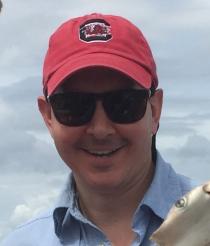School of the Earth, Ocean and Environment
Faculty and Staff Directory
Matthew E. Kimball
| Title: | Research Assistant Professor Resident Assistant Director, Baruch Field Laboratory |
| Department: | Earth Ocean and Environment College of Arts and Sciences |
| Email: | matt@belle.baruch.sc.edu |
| Phone: | 843-904-9030 |
| Office: | BMFL, Room 134 |
| Resources: | Webpage Curriculum Vitae [pdf] School of the Earth, Ocean and Environment |

Education
- 2008 - PhD, Ecology & Evolution, Rutgers University
- 2003 - MS, Zoology, North Carolina State University
- 1999 - BS, Biology, University of North Carolina at Chapel Hill
Specialization
Marine Ecology and Evolution
Research
My general research interests are in marine ecology, particularly the influence of biological and physical factors on the community dynamics of coastal fauna and flora. I am especially interested in the influence of such factors on the distribution and movement of juvenile and adult stages of estuarine and coastal fishes and invertebrates, as well as the effects of habitat on the survival and growth of these organisms. I have pursued these interests through research efforts, often combining field and laboratory approaches, in a wide range of estuarine systems and the coastal ocean along the US Atlantic and Gulf coasts.
Publications
Mace MM, III, Haffey ER, Kimball ME (2017). Low-temperature tolerance of juvenile tarpon Megalops atlanticus. Environmental Biology of Fishes (in press online).
Korsman BK, Kimball ME, Hernandez FJ (2017). Spatial and temporal variability in ichthyoplankton communities ingressing through two adjacent inlets along the southeastern US Atlantic coast. Hydrobiologia 795:219-237.
Kimball ME, Boswell KM, Rozas LP (2017). Estuarine fish behavior around slotted water control structures in a managed salt marsh. Wetlands Ecology and Management 25:299-312.
Li C, Li X, Boswell KM, Kimball ME, Lin J (2017). Estuarine plume: A case study by satellite SAR observations and in situ measurements. IEEE Transactions on Geoscience and Remote Sensing 55(4):2276-2287.
Lin J, Li C, Boswell KM, Kimball ME, Rozas LP (2016). Examination of winter circulation in a northern Gulf of Mexico estuary. Estuaries and Coasts 39:879-899.
Kimball ME, Rozas LP, Boswell KM, Cowan JH (2015). Effects of slotted water control structures on nekton movement within salt marshes. Marine and Coastal Fisheries: Dynamics, Management, and Ecosystem Science 7:177–189.
Rieucau G, Boswell KM, Kimball ME, Diaz G, Allen DM (2015). Tidal and diel variations in schooling behavior of estuarine fish within an intertidal salt marsh creek. Hydrobiologia 753:149-162.
Eash-Loucks WE, Kimball ME, Petrinec KM (2014). Long-term changes in an estuarine mud crab community: Evaluating the impact of nonnative species. Journal of Crustacean Biology 34(6):731-738.
Pawelek JC, Kimball ME (2014). Gopher tortoise ecology in coastal upland and beach dune habitats in northeast Florida. Chelonian Conservation and Biology 13(1):27-34.
Williams AA, Eastman SF, Eash-Loucks WE, Kimball ME, Lehmann ML, Parker JD (2014). Record northernmost endemic mangroves on the United States Atlantic coast with a note on latitudinal migration. Southeastern Naturalist 13(1):56–63.
Williams AA, Kimball ME (2013). Evaluation of long-term trends in hydrographic and nutrient parameters in a southeast US coastal river. Environmental Monitoring and Assessment 185:10495-10509.
Henzler JM, Xue R, Thornton A, Kimball ME, Shirley MA (2013). Mosquito species composition and seasonal abundance in a National Estuarine Research Reserve in northeast Florida. Technical Bulletin of the Florida Mosquito Control Association 9:13-16.
Kimball ME, Able KW (2012). Tidal migrations of intertidal salt marsh creek nekton examined with underwater video. Northeastern Naturalist 19(3):475-486.
Hare JA, Wuenschel MJ, Kimball ME (2012). Projecting range limits with coupled thermal tolerance - climate change models: An example based on gray snapper (Lutjanus griseus) along the U.S. east coast. PLoS ONE 7(12): e52294. doi:10.1371/journal.pone.0052294.
Wuenschel MJ, Hare JA, Kimball ME, Able KW (2012). Evaluating juvenile thermal tolerance as a constraint on adult range of gray snapper (Lutjanus griseus): A combined laboratory, field and modeling approach. Journal of Experimental Marine Biology and Ecology 436-437:19-27.
Humphries AT, La Peyre MK, Kimball ME, Rozas LP (2011). Testing the effect of habitat structure and complexity on nekton assemblages using experimental oyster reefs. Journal of Experimental Marine Biology and Ecology 409:172-179.
Kimball ME, Rozas LP, Boswell KM, Cowan JH (2010). Evaluating the effect of slot size and environmental variables on the passage of estuarine nekton through a water control structure. Journal of Experimental Marine Biology and Ecology 395:181-190.
Kimball ME, Able KW, Grothues TM (2010). Evaluation of long-term response of intertidal creek nekton to Phragmites australis (Common Reed) removal in oligohaline Delaware Bay salt marshes. Restoration Ecology 18(5):772-779.
Able KW, Grothues TM, Hagan SM, Kimball ME, Nemerson DM, Taghon GL (2008). Long-term response of fishes to restoration of former salt hay farms: Multiple measures of restoration success. Reviews in Fish Biology and Fisheries 18(1):65-97.
Kimball ME, Able KW (2007). Tidal utilization of nekton in Delaware Bay restored and reference intertidal salt marsh creeks. Estuaries and Coasts 30(6):1075-1087.
Kimball ME, Able KW (2007). Nekton utilization of intertidal salt marsh creeks: Tidal influences in natural Spartina, invasivePhragmites, and marshes treated for Phragmites removal. Journal of Experimental Marine Biology and Ecology 346:87-101.
Kimball ME, Miller JM, Whitfield PE, Hare JA (2004). Thermal tolerance and potential distribution of invasive lionfish (Pterois volitans/miles complex) on the east coast of the United States. Marine Ecology Progress Series 283:269-278.